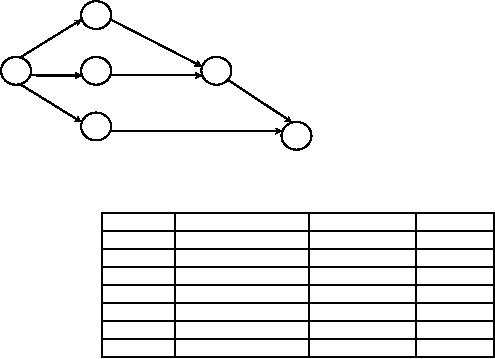 |
PERT / CPM:Expected length of a critical path, Expected time and Critical path |
| << PERT / CPM:ALGORITHM FOR CRITICAL PATH, Free Slack |
| PERT / CPM:Expected time and Critical path >> |

Operations
Research (MTH601)
42
Expected
length of a critical
path:
The
expected length of a sequence of
independent activities is simply the
sum of their separate
expected
lengths.
This gives us the expected
length of the entire
project. We have to calculate
the expected length te of
every
activity
with the weights attached to
the three time estimates
and find the critical
path in the manner
described
previously.
The expected length of the
entire project denoted by
Te is
the length of the critical
path (i.e.) the sum
of
the,
te's
of all activities along the
critical path.
In
the same way, the
variance of a sum of independent
activity times is equal to
the sum of their
individual
variances.
Since Te is
the is the sum of te's
along the critical path,
then variance of Te equals the sum of
all the
variances
of the critical activities. The
standard deviation of the
expected project duration is
the square root of the
of
the
variance Te as
calculated above.
At
this juncture, consider the
following example to illustrate the
application of these
formulae.
Example
2
1,1,7
1,1,1
1
1,4,7
3
2,5,14
5
3,6,15
2,2,8
4
6
2,5,8
Fig.
20
Activity
Expected
time (te)
Std.
deviation
Variance
1-2
(1+4+7)/6
= 2
(7-1)/6
= 1
1
1-3
(1+16+7)/6
= 4
(7-1)/6
= 1
1
1-4
(2+8+8)/6
= 3
(8-2)/6
= 1
1
2-5
(1+4+1)/6
= 1
(1-1)/6
= 0
0
3-5
(2+20+14)/6
= 6
(14-2)/6
= 2
4
4-6
(2+20+8)/6
= 5
(8-2)/6
= 1
1
5-6
(3+24+15)/6
= 7
(15-3)/6
= 2
4
For
each activity, the
optimistic mostly likely and
pessimistic time estimates
are labeled in the same
order.
Using
PERT formulae for te and St
tabulate
the results as above.
To
calculate the critical path,
list all the three
paths with their expected
time of completion from figure
21.
1-2-5-6
=
10
42
Operations
Research (MTH601)
43
1-3-5-6
= 17
1-4-6
=8
43
Table of Contents:
- Introduction:OR APPROACH TO PROBLEM SOLVING, Observation
- Introduction:Model Solution, Implementation of Results
- Introduction:USES OF OPERATIONS RESEARCH, Marketing, Personnel
- PERT / CPM:CONCEPT OF NETWORK, RULES FOR CONSTRUCTION OF NETWORK
- PERT / CPM:DUMMY ACTIVITIES, TO FIND THE CRITICAL PATH
- PERT / CPM:ALGORITHM FOR CRITICAL PATH, Free Slack
- PERT / CPM:Expected length of a critical path, Expected time and Critical path
- PERT / CPM:Expected time and Critical path
- PERT / CPM:RESOURCE SCHEDULING IN NETWORK
- PERT / CPM:Exercises
- Inventory Control:INVENTORY COSTS, INVENTORY MODELS (E.O.Q. MODELS)
- Inventory Control:Purchasing model with shortages
- Inventory Control:Manufacturing model with no shortages
- Inventory Control:Manufacturing model with shortages
- Inventory Control:ORDER QUANTITY WITH PRICE-BREAK
- Inventory Control:SOME DEFINITIONS, Computation of Safety Stock
- Linear Programming:Formulation of the Linear Programming Problem
- Linear Programming:Formulation of the Linear Programming Problem, Decision Variables
- Linear Programming:Model Constraints, Ingredients Mixing
- Linear Programming:VITAMIN CONTRIBUTION, Decision Variables
- Linear Programming:LINEAR PROGRAMMING PROBLEM
- Linear Programming:LIMITATIONS OF LINEAR PROGRAMMING
- Linear Programming:SOLUTION TO LINEAR PROGRAMMING PROBLEMS
- Linear Programming:SIMPLEX METHOD, Simplex Procedure
- Linear Programming:PRESENTATION IN TABULAR FORM - (SIMPLEX TABLE)
- Linear Programming:ARTIFICIAL VARIABLE TECHNIQUE
- Linear Programming:The Two Phase Method, First Iteration
- Linear Programming:VARIANTS OF THE SIMPLEX METHOD
- Linear Programming:Tie for the Leaving Basic Variable (Degeneracy)
- Linear Programming:Multiple or Alternative optimal Solutions
- Transportation Problems:TRANSPORTATION MODEL, Distribution centers
- Transportation Problems:FINDING AN INITIAL BASIC FEASIBLE SOLUTION
- Transportation Problems:MOVING TOWARDS OPTIMALITY
- Transportation Problems:DEGENERACY, Destination
- Transportation Problems:REVIEW QUESTIONS
- Assignment Problems:MATHEMATICAL FORMULATION OF THE PROBLEM
- Assignment Problems:SOLUTION OF AN ASSIGNMENT PROBLEM
- Queuing Theory:DEFINITION OF TERMS IN QUEUEING MODEL
- Queuing Theory:SINGLE-CHANNEL INFINITE-POPULATION MODEL
- Replacement Models:REPLACEMENT OF ITEMS WITH GRADUAL DETERIORATION
- Replacement Models:ITEMS DETERIORATING WITH TIME VALUE OF MONEY
- Dynamic Programming:FEATURES CHARECTERIZING DYNAMIC PROGRAMMING PROBLEMS
- Dynamic Programming:Analysis of the Result, One Stage Problem
- Miscellaneous:SEQUENCING, PROCESSING n JOBS THROUGH TWO MACHINES
- Miscellaneous:METHODS OF INTEGER PROGRAMMING SOLUTION